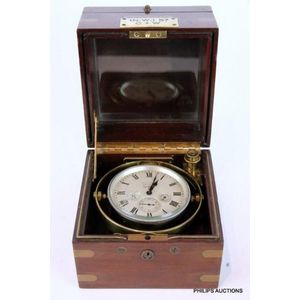Waltham Marine Chronometer, 8-Day Navigational Lever Deck, Early 20th Century
A Waltham marine chronometer, Waltham watch Co., early 20th century the 8-Day Navigational lever deck chronometer, enclosed in a weather proof case suspended on gimbals in a three-tier brass-bound mahogany box, inscribed to a white plaque '(N.W.) 57 C.W.' with the ordnance arrow, and 'Waltham' to a brass plaque, the matt silvered dial signed Waltham watch Co. And similarly inscribed, with Roman hour chapters, subsidiary up-and-down dial and seconds dial, lever escapement, 15 jewels adjusted. Height 12.5 cm, width 12.5 cm, depth 12.5 cm, (case)
You must be a subscriber, and be logged in to view price and dealer details.
Subscribe Now to view actual auction price for this item
When you subscribe, you have the option of setting the currency in which to display prices to $Au, $US, $NZ or Stg.
This item has been sold, and the description, image and price are for reference purposes only.
- Mahogany - Mahogany is a dense, close grained red-coloured timber from the West Indies and Central America. It was first imported into Europe in the the early 18th century and its use continued through the 19th century. It was popular for furniture making because of its strength, the wide boards available, the distinctive grain on some boards, termed flame mahogany and the rich warm colour of the timber when it was polished.. The "flame" was produced where a limb grew out from the trunk of the tree, and this timber was usually sliced into veneers for feature panels on doors, backs and cornices.
Some terms used to describe mahogany relate to the country from which it originally came, such as "Cuban" mahogany, "Honduras" mahogany etc. However unless the wood has been tested the names assigned are more a selling feature, rather than a true indication of the timber's origin. - Lever Escapement - A lever escapement is a type of escapement mechanism used in mechanical clocks and watches to regulate the timekeeping of the movement. It was invented by British clockmaker Thomas Mudge in the 18th century and is now widely used in modern mechanical timepieces.
The lever escapement consists of three main parts: the escape wheel, the pallet fork, and the lever. The escape wheel is a wheel with teeth that is driven by the clock or watch's main spring or weight. The pallet fork is a two-pronged component that is positioned so that it can engage with the teeth of the escape wheel, and the lever is a small, L-shaped component that is attached to the pallet fork.
When the escape wheel turns, one of its teeth pushes against one of the pallet fork's prongs, causing the fork to pivot. As the pallet fork pivots, it releases the tooth and engages with the next tooth on the opposite side of the escape wheel. At the same time, the lever, which is connected to the pallet fork, rocks back and forth, allowing the escape wheel to turn at a regulated rate.
The lever escapement is prized for its accuracy and reliability and is commonly used in high-end mechanical watches. It allows for precise timekeeping by ensuring that the movement of the watch or clock is regulated and consistent, and its compact size makes it an ideal choice for use in small, portable timepieces.
This item has been included into following indexes:
